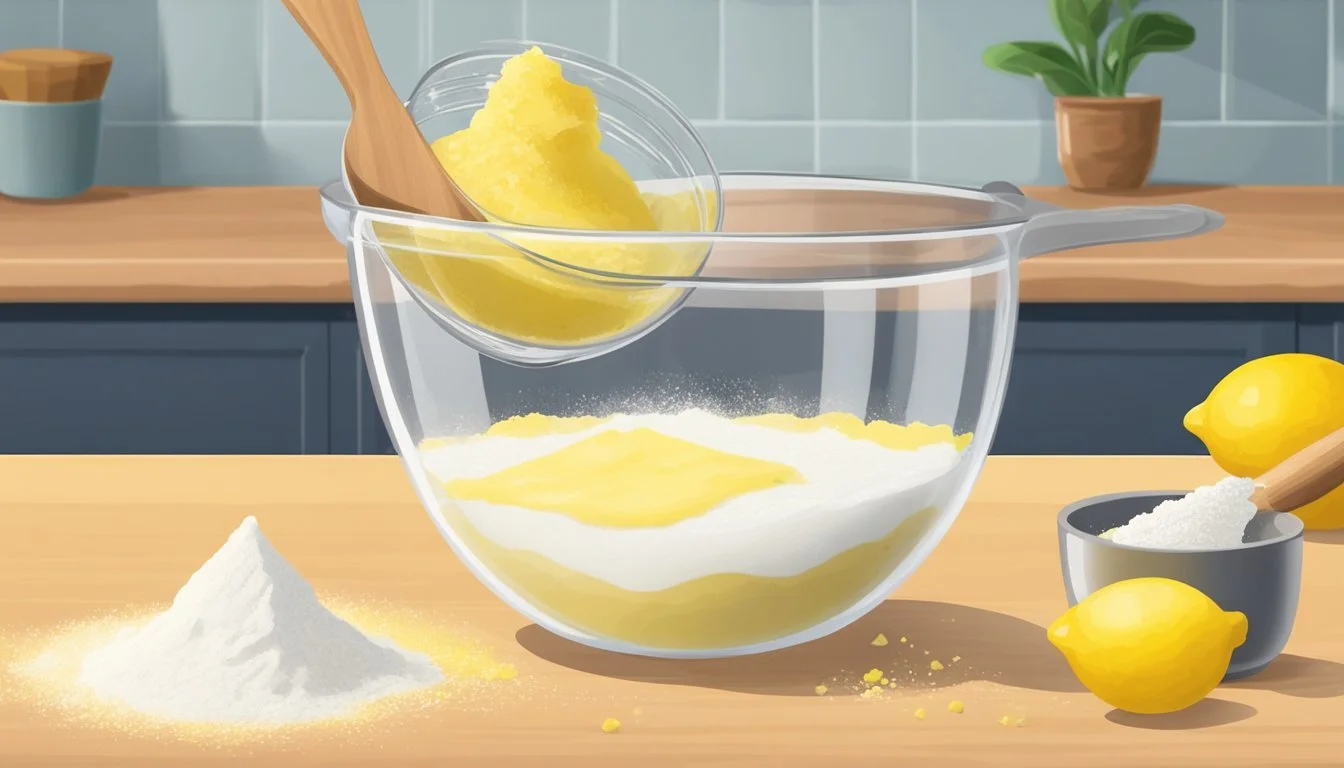How do you eat a lemon drizzle cake?
Savoring Each Tangy Bite to the Fullest
Lemon drizzle cake is a delightful treat that tempts the palate with its balance of sweet and tangy flavors. This classic cake is moist, zesty, and topped with a lemon syrup that crystallizes to create a sparkling glaze. Its popularity is widespread, and it's a staple in both home baking and professional patisseries due to its simple yet satisfying flavors.
The process of making a lemon drizzle cake typically involves combining flour, sugar, butter, eggs, and of course, lemons. Bakers often zest the lemons to infuse the batter with a strong citrus aroma and than juice them to contribute to the drizzle. The finished product is a light and fluffy cake that carries a refreshing burst of lemon, making it perfect for serving as an afternoon snack, a dessert item, or even as a celebratory cake for special occasions.
When it comes to eating a lemon drizzle cake, the approach is a matter of personal preference. Some might enjoy it warm, fresh from the oven, which allows the lemon flavor to stand out boldly. Others prefer it cool, which gives the sugar drizzle time to set and add a slight crunch to the texture. Alongside a cup of tea or a dollop of clotted cream, this cake is typically savored as a quintessential part of British teatime, however, it has gained admiration worldwide.
Choosing the Right Ingredients
Selecting the best ingredients is crucial for the success of a lemon drizzle cake. The quality of lemons, the correct type of flour and raising agents, and the choice of fats and sugars contribute to the cake's texture and taste. This section details how to choose these components for a delightful baking experience.
Selecting Quality Lemons
For the best flavor, one should opt for unwaxed lemons since they are free from the wax coating that affects zest quality. Large, ripe lemons are preferable as they provide more juice and zest. When zesting, use only the outer yellow skin to avoid the bitter white pith.
Flour and Raising Agents
Self-raising flour is typically used to provide the cake with the lightness and rise it needs. If unavailable, one can substitute with all-purpose flour combined with baking powder—one teaspoon per cup of flour. Ensure the baking powder is not expired for maximum effectiveness.
Fats and Sugars
Unsalted butter is often recommended for its ability to control the cake's salt content, though salted butter can also be used with an adjustment to added salt. For sugars, caster sugar is ideal due to its fine granules that dissolve easily, but granulated sugar can be an alternative. The choice between them can alter the texture slightly.
Additional Ingredients
In addition to the main ingredients, incorporate eggs at room temperature for a uniform mixture. Whole milk adds moisture, while a teaspoon each of vanilla extract and lemon extract enhance the lemon flavor. A pinch of salt is essential, even if using salted butter, to balance the sweetness.
Preparing the Batter
Making a lemon drizzle cake batter involves a thoughtful process that starts with creaming butter and sugar together to create a fluffy base before gradually incorporating eggs and lemon flavor, and gently folding in the dry ingredients to maintain a light texture.
Creaming Butter and Sugar
A crucial step in crafting the perfect batter for a lemon drizzle cake is the creaming of butter and sugar. Using a stand mixer or a hand mixer, one should beat the room-temperature butter with sugar until the mixture is pale and voluminous. This process introduces air into the batter, crucial for a light and fluffy texture. Adding lemon zest at this stage infuses the batter with a vibrant lemon flavor.
Cream butter and sugar until light and fluffy, approximately 4-5 minutes.
Incorporate finely grated lemon zest for a fresh citrus aroma.
Incorporating Eggs and Flavors
Once the butter and sugar are well-creamed, it's time to add eggs one at a time, ensuring each one is fully incorporated before adding the next. The eggs contribute to the structure and richness of the cake. To enhance the lemon flavor, lemon juice, or lemon extract can be added along with a hint of vanilla extract for depth.
Mix in eggs one at a time, followed by lemon juice or extract and vanilla extract.
Mix until each egg is just incorporated before adding the next.
Folding in Dry Ingredients
The final step in preparing the batter comes down to carefully folding in the sifted dry components: all-purpose flour, baking powder, and salt. This is done by gently stirring the mixture until just combined, being careful not to overmix, as that could deflate the batter and result in a denser cake.
Fold in sifted flour, baking powder, and salt until just combined.
Avoid overmixing to ensure a light and airy batter.
Baking the Cake
Baking a lemon drizzle cake requires precise preparation and timing. The following steps ensure the cake maintains the right texture and doesn't sink in the middle.
Prepping the Loaf Tin
Before mixing any batter, one must properly prepare the loaf tin to prevent sticking. They should:
Grease the loaf tin thoroughly with butter or non-stick spray.
Line the tin with parchment paper, also known as greaseproof or baking paper, trimming it to fit snugly. This makes it easier to lift the cake out once baked.
Ensuring Proper Baking
Achieving a perfectly baked lemon drizzle cake hinges on:
Preheating the oven to the correct temperature, typically between 160°C (320°F) and 180°C (350°F), depending on whether the oven is fan-assisted.
Pouring the batter into the loaf tin and smoothing the top.
Placing the tin on a middle rack in the oven to ensure even heat distribution.
Baking for the recommended baking time, which generally ranges from 35 to 45 minutes.
Using a skewer or toothpick to test doneness - it should come out clean when inserted into the center of the cake.
Once done, placing the cake on a wire rack allows it to cool without becoming soggy.
By following these subprocesses, bakers can ensure their cake comes out golden, fluffy, and ready for the final lemon drizzle.
Creating the Lemon Drizzle
In the making of a lemon drizzle cake, the drizzle itself is a crucial component. It adds moisture and a zesty sharpness that perfectly complements the sweet cake. The lemon drizzle is usually prepared while the cake is baking, ready to be applied once the cake is adequately baked.
Mixing the Drizzle Ingredients
The lemon drizzle is a simple syrup made primarily from fresh lemon juice and sugar. In a small saucepan, one usually combines equal parts of sugar and freshly squeezed lemon juice. For a traditional lemon drizzle cake, granulated sugar is often used, but for a more refined finish, icing sugar can be substituted. The mixture is heated gently until the sugar dissolves completely, creating a tangy lemon syrup.
Ingredients for Lemon Drizzle:
Lemon juice, freshly squeezed
Granulated or icing sugar
Piercing and Drizzling the Cake
As soon as the cake is removed from the oven, while it is still warm, the next step is to evenly pierce the top of the cake with a skewer. These holes allow the lemon syrup to penetrate deeply into the cake, ensuring every bite is infused with the bright flavor of the lemon. The warm syrup is then drizzled over the surface, where it seeps into the cake, adding moisture and creating a delicate sugary crust once it cools.
Steps for Drizzling:
Pierce the warm cake with a skewer at regular intervals.
Pour the hot lemon syrup over the cake, allowing it to soak in fully.
Finishing Touches and Presentation
Finishing touches and presentation play a crucial role in enhancing the flavors of a lemon drizzle cake and making it visually appealing. A well-presented cake entices the senses and sets the anticipation for the first bite.
Applying Lemon Glaze or Curd
The application of lemon glaze or lemon curd is a critical step in preparing a lemon drizzle cake. For the glaze, one should mix powdered sugar, melted butter, lemon juice, and zest until the consistency is smooth and glossy. It's essential to adjust the lemon juice quantity to achieve the desired thickness. If lemon curd is preferred, applying it while the cake is warm allows it to soak in, creating an intense lemon flavor.
Decorating with Toppings
A lemon drizzle cake's appearance can be elevated with a variety of toppings. Freshly-grated lemon zest sprinkled on top can add a burst of color and tanginess. Those looking for additional texture may consider:
Nuts: A handful of chopped pistachios or almonds.
Edible flowers: Small, pesticide-free flowers for a touch of elegance.
Each ingredient should complement the tartness of the lemons without overpowering the cake's natural flavor.
Serving Suggestions
Presentation of the lemon drizzle cake is key to a memorable experience, especially for occasions like afternoon tea. One should serve it:
On a fine china plate to reflect traditional afternoon tea elegance.
As individual servings, neatly plated with a dollop of lemon curd or fruit compote to the side if desired.
Whether serving for an everyday treat or a special event, these final touches can make the lemon drizzle cake a highlight of the meal.
Storing and Keeping the Cake
Proper storage is essential to maintaining the fresh flavor and moist texture of a lemon drizzle cake. The cake's shelf life can be maximized by using refrigeration for short-term freshness or freezing for longer storage.
Refrigerating for Freshness
To keep the lemon drizzle cake fresh, one should refrigerate it within two hours of baking. It should be placed in an airtight container or tightly wrapped in plastic wrap to prevent it from drying out. The moist environment will help preserve its delicate crumb and citrusy flavor. Refrigeration can effectively extend the cake's shelf life to about 5 days.
Freezing for Long-Term Storage
For long-term storage, freezing the lemon drizzle cake is an excellent option. Before freezing, ensure the cake is completely cooled to prevent condensation, which can lead to sogginess. Wrap the cake tightly in plastic wrap, followed by aluminum foil to safeguard against freezer burn. Store it in an airtight container to protect it from absorbing other flavors. When stored correctly, a frozen lemon drizzle cake can maintain its quality for up to one month. When ready to consume, thaw the cake in the refrigerator for several hours before bringing it to room temperature for serving.
Nutritional Information
When indulging in a lemon drizzle cake, one should be aware of its nutritional profile, which includes caloric content and the balance of macronutrients. This delicious treat can vary in its nutrient composition, depending on the recipe and serving size.
Counting Calories and Macronutrients
Lemon drizzle cake, characterized by its tangy flavor and moist texture, provides a notable amount of calories and macronutrients. For every 63g serving, which is approximately 0.17 of a cake, the nutritional values are as follows:
Calories: 230
Total Fat: 8.2g
Saturated Fat: 10g
Trans Fat: 0.6g
Polyunsaturated Fat: 1g
Monounsaturated Fat: 4.6g
Carbohydrates: Varied (specifics not provided)
Fiber: Not specified
Protein: Varied (specifics not provided)
In a larger 1-piece serving, the cake has different nutrition values:
Calories: 326
Total Fat: 17g
Saturated Fat: 10g
Cholesterol: 102mg
Vitamins and Minerals Content
The content of vitamins and minerals in lemon drizzle cake can contribute to an individual's daily nutritional requirements. However, the search results do not provide specific amounts for vitamins and minerals like sodium, potassium, calcium, iron, and vitamin A for lemon drizzle cake. It is suggested to consult the specific recipe and ingredients used to assess the micronutrient content accurately. Given that lemon juice is commonly used in the cake, there is the potential for vitamin C content, but the exact amount would depend on the recipe.
Variations of Lemon Drizzle Cake
Lemon drizzle cake can be adapted into an array of delightful variations, each offering a unique twist on the classic recipe. Whether one is seeking an easy bake or a more indulgent treat, these variations cater to different tastes and preferences.
Alternative Lemon Cake Recipes
Easy Lemon Drizzle Cake: Beginners might prefer an easy recipe that typically involves mixing basic ingredients like flour, sugar, butter, eggs, and lemon zest. The simplicity of the process ensures that even novice bakers can produce a moist and flavorful cake.
Moist Lemon Drizzle Cake: Achieving a moist cake often entails the inclusion of yogurt or buttermilk in the batter. This adds a tender crumb to the bake and ensures the cake remains succulent.
Cupcakes: Lemon flavors adapt well into cupcakes, offering a bite-sized option. Adding lemon zest to the batter and topping with a lemon-infused frosting can enhance the citrusy punch.
Loaf Cake Recipes: Most commonly, lemon drizzle cakes are baked as loaf cakes. This format is ideal for slicing and often used when preparing the cake as an afternoon treat.
Incorporating Nuts and Fruits
Ground Almonds: Bakers can add ground almonds to the batter for a nutty texture and rich flavor. Almonds can also complement the zesty lemon with their subtle sweetness.
Fruit Compote: Serving the cake with a fruit compote, such as berry or peach, can add a refreshing contrast to the sweet and tart lemon flavor.
In the world of baking, creativity with recipes like lemon drizzle cake is welcomed. The additional textures and flavors from nuts and fruits can elevate the classic recipe into a gourmet experience.
Common Pitfalls and Troubleshooting
When preparing lemon drizzle cake, one may encounter specific issues such as a soggy bottom or the cake sinking in the middle. Understanding how to avoid these common pitfalls and adjusting baking practices can lead to a more consistently successful outcome.
Avoiding a Soggy Bottom or Sinking
The dreaded soggy bottom can occur when the cake has not been baked long enough or at a high enough temperature to set the base, resulting in a moist and uncooked texture. To prevent this:
Ensure appropriate baking time: Each oven is different, so one might need to extend the baking time slightly beyond what the recipe suggests.
Check the cake's position in the oven: Placing the cake on the lower rack can sometimes cause a soggy bottom due to less heat reaching the bottom of the baking pan. Position it in the middle of the oven instead.
If a lemon drizzle cake sinks in the middle, it can be due to the improper mixing of ingredients or opening the oven door too early, which causes a sudden temperature change:
Mix to the right consistency: Over-mixing the batter can incorporate too much air, which might collapse and cause sinking. Mix just until the ingredients are combined.
Keep the oven door closed: Avoid opening the oven door too often, as temperature fluctuations can cause sinking. Only open the door to check towards the end of the baking time.
Adjusting Baking Time and Temperature
Baking time and oven temperature are crucial in achieving the perfect lemon drizzle cake. Follow these tips:
Preheat the oven: Always start with a fully preheated oven to the temperature specified in the recipe—usually around 160°C (320°F) for a fan oven or 180°C (356°F) for a conventional one.
Know your oven: If one finds that baked goods are consistently under or overcooked, an oven thermometer can help to check if the oven reaches and maintains the correct temperature.
Remember, each oven is unique and may require slight adjustments to the recipe's suggested temperature or baking time. Always use a skewer or a toothpick to test the doneness of the cake by inserting it into the center. If it comes out clean, the cake is ready.
Connecting with the Community
When it comes to enjoying a lemon drizzle cake, the experience can extend beyond the last bite. Sharing this delightful dessert can foster a sense of community and connection, especially when paired with activities like afternoon tea or social media interactions.
Sharing on Social Media
Facebook: By creating a post or a photo album of their lemon drizzle cake, individuals can share their baking success with friends and family. A Facebook post might include photos of the cake at different stages – from baking to serving – along with a brief description or personal story, evoking reactions and comments that bring people together.
Example of Facebook Post:
Caption: "Afternoon delight! Just whipped up a lemon drizzle cake for tea time. Here's to adding a little zest to our day! ☕🍋 #LemonDrizzleCake #AfternoonTea"
Photos: A series of images showing the fluffy, moist cake, drizzled with the tangy lemon icing, perhaps alongside a cup of tea
Pinterest: This platform is perfect for individuals to not only share their own lemon drizzle cake creations but also to find inspiration and offer advice. A well-organized Pinterest board can include various recipes, presentation ideas, and tips for the perfect cake.
Pinterest Board Ideas:
Pin 1: The recipe they used, citing any personal adjustments made
Pin 2: Styling their lemon drizzle cake for afternoon tea
Pin 3: Pairing suggestions for drinks or other foods that complement the cake's flavors
Famous Lemon Drizzle Cake Inspirations
Lemon drizzle cake has been a perennial favorite, with various recipes surfacing from renowned culinary personalities. These recipes not only offer a classic taste but also bring a sense of sophistication to the simple pleasure of a citrus-infused treat.
Celebrity Chef Recipes
Paul Hollywood
Renowned for his expertise in baking, Paul Hollywood presents a recipe that emphasizes a light and fluffy texture. His method involves beating the butter, sugar, and lemon zest to a very pale consistency, which is then baked to golden perfection.
Lemon Drizzle Technique: Once baked, a mixture of sugar and lemon juice is heated and drizzled over the warm cake.
Mary Berry
A household name, Mary Berry's lemon drizzle cake stands out with its moist texture. She endorses the importance of a well-prepared cake tin and baking at the correct temperature for the right amount of time.
Baking Tip: The cake is done when it turns golden brown, and a skewer inserted into the middle comes out clean.
Seasonal Considerations and Events
The lemon drizzle cake shines particularly during the spring, aligning with the season's association with citrus flavors. The cake's zestiness complements springtime occasions, offering a refreshing treat that echoes the renewal of the season.
Springtime Lemon Treats
With its bright, zesty flavor, lemon drizzle cake becomes a fitting choice for various spring events. After the heavier indulgences of winter, the lightness of lemons provides a palate-cleansing alternative. Mother's Day, Easter, and springtime garden parties are all ideal occasions to feature a lemon drizzle cake on the dessert menu.
Mother's Day: Serving a lemon drizzle cake expresses appreciation with a homemade touch.
Easter: The cake pairs well with other Easter treats, offering a tangy counterpoint.
Garden Parties: Complementing spring's blossoming scenery, this cake acts as a conversation-starter.
When presenting a lemon drizzle cake in spring, one might consider garnishing with edible flowers or fresh lemon slices for a seasonal and photogenic finishing touch.
Final Thoughts
Eating a lemon drizzle cake is an experience that balances the tartness of lemon with the sweetness of sugar. This dessert is beloved for its moist texture and refreshing flavor profile, where the tangy lemon zest and juice infuse the cake with a bright citrus note.
Textural Contrast:
A well-made lemon drizzle cake features a soft, tender crumb that contrasts delightfully with the crunchy sugar crust formed by the lemon-sugar drizzle.
Serving Suggestions:
Lemon drizzle cake can be served as is, or with a dollop of cream or a scoop of vanilla ice cream for those who prefer a creamy component.
It pairs beautifully with a hot cup of tea or a cold glass of milk.
Time of Day:
Typically enjoyed as an afternoon treat, this cake is equally suitable for a brunch item or a post-dinner dessert.
Storage Tips:
To maintain its moistness, the cake should be stored in an airtight container.
Garnish Options:
For an added touch of elegance, one can garnish the cake with a sprinkle of lemon zest or edible flowers before serving.
In essence, a lemon drizzle cake offers a simple yet satisfying dessert option for various occasions. Its popularity lies in its straightforward flavor combination of tart and sweet, promising a delicious treat for those who savor it.












